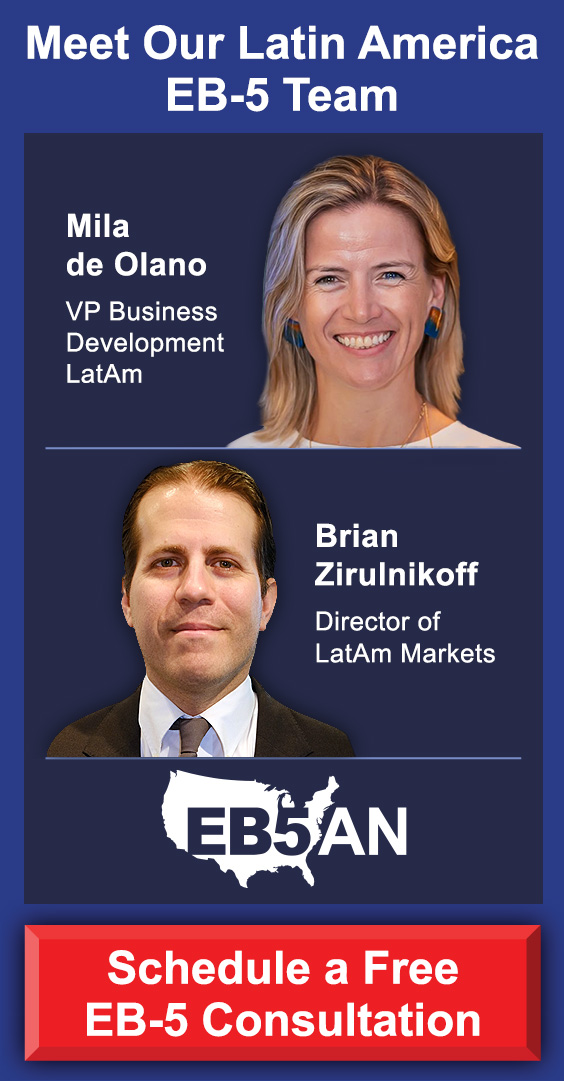Learn how to prove that EB-5 funds were obtained lawfully.
Knowing what to do to prove the lawful source of your funding when investing in an EB-5 project is a daunting task for just about every EB-5 investor.
Whether it’s gathering all the required documents and financial records, such as bank accounts statements and mortgage documents, or explaining complex business structures and gifts or loans—help from an EB-5 attorney can be invaluable in navigating the source of funds process.
In this article we will cover the most common EB-5 source of funds for you as an EB-5 investor, and discuss the ways in which you can prove where your investments come from.
What Is the EB-5 Visa Investment Program?
- Direct Investments vs. the EB-5 Regional Center Program
- Requirements for EB-5 Investors
- Submitting Form I-526E
Source of Funds for EB-5 Investments
Common Documents for Proving the Lawful Source of Funds
- Documents showing salary and income sources
- Earnings from a business
- Documents showing stock earnings
- Documents showing earnings from the sale of a property
- Documents showing that an investor has received a loan
- Documents showing that an investor has received a gift or donation
- Documents showing that an investor has received an inheritance
- Documents proving a legal judgment in any country
Advice for Proving Lawful Source of Funds
Evidence of Investment of Funds
What Steps Can Interested Individuals Take to Get Started on the EB-5 Investment Process?
What Is the EB-5 Visa Investment Program?
The EB-5 visa program was established in 1990 to stimulate the U.S. economy by encouraging foreign investors to fund U.S. commercial enterprises.
EB-5 investors who meet all the requirements of the EB-5 Immigrant Investor Visa program can get Green Cards for themselves and immediate family members, including spouses and children younger than 21 years of age.
The EB-5 visa program is one of the quickest ways for foreign nationals to secure U.S. resident status for themselves and their qualifying family members.
Direct investments vs. the EB-5 Regional Center Program
When making EB-5 investments, EB-5 investors can choose between the direct investment model and the regional center program.
What is a direct investment model?
Individuals who make direct investments put investment capital directly into a new commercial enterprise.
What is a regional center program?
Regional centers are economic units that have been authorized to manage EB-5 investment projects, instead of having EB-5 applicants invest directly.
There are a few differences between the direct investment model and the EB-5 regional center program.
More lenient criteria
The main difference is that more lenient criteria apply to EB-5 regional center projects when it comes to proving that an investment has met the job creation requirement set by United States Citizenship and Immigration Services (USCIS).
Defined job creation requirements
Each EB-5 investment must create 10 jobs. Regional center projects may count indirect jobs toward the job creation requirement, while direct investments and invested funds may only count direct jobs. Direct jobs consist of W-2 employees of the commercial enterprise. Indirect jobs do not have to be W-2 employees of the enterprise itself, but can be jobs created as a result of the EB-5 investment project’s economic impact.
In the case of regional center projects, indirect jobs can count for up to 90% of the jobs that go toward fulfilling the job creation requirement for EB-5 investments. This means that an investment in a regional center project must create at least one direct job.
Enhanced security
Most investors choose to work with regional centers to make their EB-5 investments. The regional center program became even more attractive to investors after the passage of the EB-5 Reform and Integrity Act of 2022 in March 2022. The Act includes policies that provide additional oversight for EB-5 regional centers, making the regional center program an even more secure option for investors.
Requirements for EB-5 Investors
There are several requirements that EB-5 investors must fulfill. Because one of the main goals of the EB-5 visa program is to create jobs for workers in the United States, each EB-5 investment must result in 10 jobs with full-time hours that last for at least two years. Additionally, an EB-5 investment must be made in a new commercial enterprise.
Investment funding requirements
There are also requirements regarding the number of funds that must be invested. EB-5 investments in EB-5 projects located in targeted employment areas (TEAs) must be a minimum of $800,000. Investments in a new commercial enterprise not located in a TEA must be at least $1,050,000.
Investment location
Targeted employment areas are high-unemployment or rural areas designated by United States Citizenship and Immigration Services. High-unemployment TEAs must have an unemployment rate higher than 150% of the U.S. average. To be designated as a rural TEA, an area should:
- Be located in a metropolitan statistical area.
- Have a poluation lower than 20,000.
- Not share a border with an municipality that has a population larger than 20,000.
At-risk investment requirement
EB-5 investment funds must remain at risk for the entire duration of the investment. This requirement is in place to prevent the simple “buying” of U.S. Green Cards and ensure that true investments are made.
Proving the source of funds
Lastly, an important requirement is that the investment capital put toward an EB-5 investment must be legally obtained, and the investor must submit paperwork to the United States Citizenship and Immigration Services proving evidence of source of funds.
Submitting Form I-526E
Once a qualifying investment has been made, an investor must file Form I-526E, Immigrant Petition by Regional Center Investor, with the immigration service. Investors already in the United States may file Form I-485 to adjust their immigration status at the same time they file Form I-526E.
Upon approval of Form I-526E, investors and their family members will receive visas that grant them conditional U.S. resident status. These visas last two years, near the end of which period investors submit Form I-829. Upon approval of Form I-829, investors and their family members will become permanent residents of the United States.
Along with Form I-526E, investors must submit paperwork proving their investment has met the requirements of the EB-5 visa program, including documentation showing that the capital put toward the EB-5 investment was obtained legally.
Proving the Source of Funds for EB-5 Investments
Proving the source of funds is an important requirement that EB-5 investors must satisfy before they can be approved for U.S. Green Cards.
Common sources of funds used for EB-5 investments
Funds from a variety of sources are acceptable when it comes to EB-5 investments, as long as they are from a legal source and evidence demonstrating their legality can be provided to the United States Citizenship and Immigration Services. Some of the most popular source of funds for EB-5 investments is listed below:
- Salary and wages from labor, services, etc.
- Income from a business.
- Income from a patent.
- Funds earned from royalties on a publication.
- Interest accrued on an investment or savings account may be put toward an EB-5 investment.
- Loans to make EB-5 investments, as long as investors can prove that the loan provider sourced the loan funds legally.
- Gifted funds from friends and family for EB-5 investments, as long as investors can prove that the gifted funds were acquired legally. Individuals with children older than 21 years of age, or who do not want to immigrate to the United States themselves, may gift their children the funds to make an EB-5 investment.
- Donations can be used to make EB-5 investments, as long as investors can prove that the donation was sourced legally.
- Funds from criminal or civil legal settlements.
- Inheritances.
- Income gained from the selling of property.
This is not an exhaustive list of all acceptable sources of funds for EB-5 investments. There may be other fund sources not listed here that can still be used for EB-5 investments. The key point to remember is that the funds must be legally sourced.
Common Documents for Proving the Lawful Source of Funds
Before beginning the EB-5 investment process, an investor should ensure that they have documentation that can be used as evidence that funds have been lawfully sourced. This documentation must be valid and up to date. The following documents may be used to prove that EB-5 funds have been lawfully obtained:
- Documents showing salary and income sources: Documentation that can be used to prove that funds were attained through salary earnings include: W-2s, personal income tax returns from the past five years, bank statements, employment contracts, and paperwork provided by an employer that explains how long an investor worked for them and how much compensation the investor received for their work.
- Earnings from a business: Funds earned from a business can be proven by providing documents like business tax returns, financial statements, employment contracts, and business registration records.
- Documents showing stock earnings: Documentation that can be used as evidence of investment earnings includes stock certificates from the past three years, securities accounts and investment account paperwork.
- Documents showing earnings from the sale of a property: To prove they acquired investment capital from the sale of a property or similar income-generating assets, investors can provide a deed certificate and/or a bill of sale.
- Documents showing that an investor has received a loan: If an investor uses a loan for an EB-5 investment, they must provide bank statements proving they have received the loan as well as documentation showing that the loan funds themselves were sourced lawfully.
- Documents showing that an investor has received a gift or donation: Investors must provide documentation showing that they have received a gift or donation, in addition to documents proving that the gift and/or donation funds were lawfully sourced.
- Documents showing an investor has received an inheritance: When an inheritance is used for an EB-5 investment, paperwork showing that an investor received an inheritance, such as wills and/or documents from an estate administrator, should be included with Form I-526E.
- Documents proving a legal judgment in any country: Funds received as the result of a legal settlement, such as a lawsuit or divorce case, may be used toward EB-5 investments. In this case, a certified copy of the judgment must be provided to the United States Citizenship and Immigration Services.
This list is not exhaustive document list. Other types of paperwork may also be used as evidence that EB-5 investment funds were obtained legally.
Immigration attorneys can help investors determine what types of documents can be used to prove that their EB-5 investment funds were sourced through lawful means.
In addition, bank account statements will be important evidence to prove the source of funds. Tax returns and bank statements should be included in an EB-5 investors’ I-526E petition, and these bank statements should be official. A currency transaction report may also be required.
Advice for Proving Lawful Source of Funds
Before making an EB-5 investment, an investor should put EB5 investment funds in a separate account designated for that purpose. This will make it easier to track funds and prove that an investment has been made.
Document translation
EB-5 investors should be aware that any documents not originally in English will need to be officially translated and English copies will need to be provided to United States Citizenship and Immigration Services. Investors should leave ample time to obtain any translations of documents that should be included in their EB-5 applications.
Hiring an immigration attorney
It is in the EB-5 investor’s best interest to consult with an immigration attorney even before beginning the EB-5 investment process. Immigration attorneys can assist investors in navigating the intricacies of the EB-5 visa application process. Since each EB-5 investor’s situation is unique, and an immigration attorney can help individual investors take the best approach to proving their funds have been legally obtained.
Evidence of Investment of Funds
In addition to proving that their funds have been lawfully sourced, investors will also need to provide evidence that they have made a qualifying investment. In addition, investors need to prove that their funds remained at risk for the duration of the investment.
Investors can prove that they made a qualifying investment by submitting bank statements and paperwork documenting wire transfers. When it comes to proving that an investment has been made, it is especially helpful to follow the advice provided above and to put investment funds in a designated account to make them easier to track.
Statements from a bank or financial institution and tax returns constitute an important part of source of funds documentation.
What Steps Can Interested Individuals Take to Get Started on the EB-5 Investment Process?
Investing in an EB-5 project promises the quickest route to obtaining a U.S. Green Card. It does however come with a fairly detailed process that needs to be followed correctly to ensure a successful outcome.
To get started on the EB-5 investment process, prospective investors should:
Understand the EB-5 Program
Thoroughly research and understand the EB-5 Immigrant Investor Program. Familiarize yourself with the program’s eligibility criteria, investment requirements, job creation rules, and the general processes. EB5AN is here to help you with all the information that you need. You can view our blog and resources to learn more about the EB-5 investment process.
Determine eligibility
Ensure that you meet the eligibility criteria for the EB-5 program. This typically includes having the required minimum investment amount and demonstrating that the investment will create or preserve at least 10 full-time jobs for qualifying U.S. workers.
Choose a suitable investment project
Research EB-5 investment projects to find one that aligns with your investment goals and risk tolerance. EB5AN provides you with access to a range of suitable EB-5 investment opportunities.
Wanting a secure and guaranteed EB-5 investment opportunity?
The Twin Lakes EB-5 Project ticks every box. Learn more about it.
Engage with immigration attorneys
Consult with an experienced immigration attorney such as EB5AN who specializes in EB-5. This will ensure that you understand the legal requirements, ensure eligibility, and get guidance throughout the EB-5 investment process.
Prepare source of funds documentation
Gather all the necessary financial documents to prove the lawful source of your investment funds. This may include tax returns, bank statements, employment contracts, property sale agreements, and other evidence of fund origin.
Complete the I-526E petition
File the I-526E petition with the U.S. Citizenship and Immigration Services (USCIS). This petition establishes your eligibility and intent to invest in the EB-5 program.
Await I-526E approval
After submitting the I-526E petition, wait for USCIS to adjudicate your application. The processing time can vary, so be patient during this stage.
Sid Sinha was granted his employment authorization document (EAD) and travel permit just 60 days after filing the required forms.
Meet Sid and read his testimonial.
Invest the funds
Once the I-526E petition is approved, transfer the investment funds to the selected project’s escrow account or directly invest in the new commercial enterprise.
Monitor job creation
If you have invested in a regional center project, closely track the job creation process to ensure that the required number of jobs are created or preserved as per the program’s requirements.
Looking to secure 10 or more jobs for an EB-5 investment?
The Twin Lakes Georgia EB-5 Project has created 1,800 jobs for investors thus far. Learn more about it.
File the I-829 petition
After the required job creation is confirmed, file the I-829 Petition to Remove Conditions on Permanent Residence. This petition demonstrates that you have met the EB-5 program’s job creation requirements.
Obtain a conditional green card
If the I-829 petition is approved, you and your qualifying family members will be granted conditional permanent resident status, which is valid for two years.
Apply for permanent residency
Once the conditional Green Card is obtained, you and your family can live and work anywhere in the United States as lawful permanent residents.
The Last Word
Any investor ready to embark on the EB-5 investment process should remember that it is of utmost importance to ensure that they can locate the appropriate paperwork to prove a lawful source of funds.
Having all this paperwork easily accessible will make the application process smoother for the investor. The quicker an investor can gather the appropriate paperwork to be submitted with Form I-526E, the faster they can get approved for a U.S. Green Card and become a permanent U.S. resident.
To find out more about how to prove that an EB-5 investment meets the lawful source of funds requirement, or to get started on the EB-5 investment process, investors should contact EB5AN. Investors can get in contact with EB5AN by emailing info@EB5AN.com. They can also schedule a time to speak with a knowledgeable consultant about EB5 investment options and how to prepare bank account statements, report cash transactions, procure mortgage documents, craft financial statements, and prepare other source of funds documentation.










